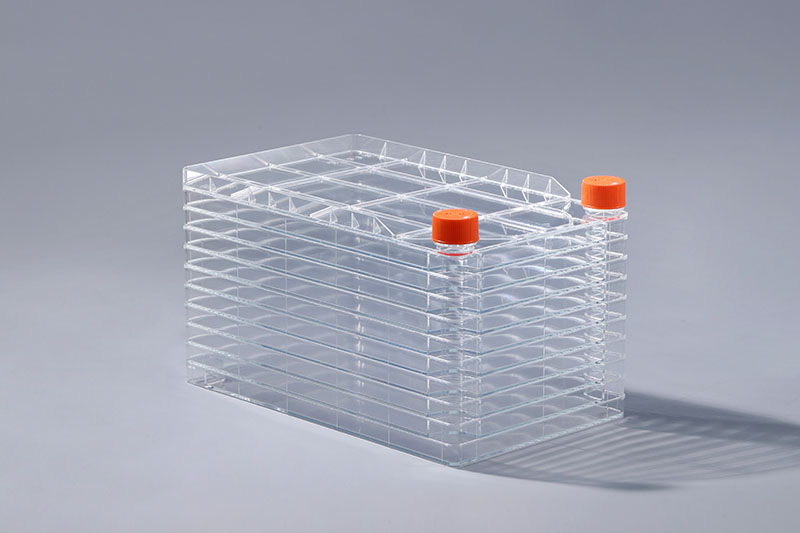S hĺbkovým vývojom v oblasti biologických vied sa technológia bunkovej kultúry široko používa v mnohých oblastiach, ako sú biofarmaceutiká, priemyselná výroba vakcín a monoklonálne protilátky. Podľa rôznych spôsobov bunkového rastu sa delí na dve kategórie: adherentné bunky a suspenzné bunky. Ktoré bunky je teda možné kultivovať pomocou bunkových tovární?
Bunková továreň je viacvrstvová štruktúra spotrebného materiálu pre bunkové kultúry. Bežné špecifikácie zahŕňajú 1 vrstvu, 2 vrstvy, 5 vrstiev, 10 vrstiev, 40 vrstiev atď. Používa sa hlavne na kultiváciu adherentných buniek. Rast adherentných buniek musí mať podporný povrch, ktorý sa môže pripojiť, a bunky môžu rásť a reprodukovať sa na tomto povrchu spoliehaním sa na faktory pripojenia, ktoré samy vylučujú alebo ktoré sú poskytnuté v kultivačnom médiu. Po prichytení bunky zvyčajne pokrývajú povrch kultúry v priebehu niekoľkých dní a vytvoria hustú bunkovú monovrstvu, ako sú bunky Vero, bunky HEK 293, bunky CAR-T, MRC5, bunky CEF, alveolárne makrofágy ošípaných, bunky myelómu, DF - 1 bunky, ST bunky, PK15 bunky, Marc145 bunky atď. boli všetky priľnuté k bunkovej továrni na kultiváciu. Okrem toho sa tento spotrebný materiál môže použiť aj na stacionárnu kultiváciu suspenzných buniek. Suspenzné bunky označujú bunky, ktoré rastú nezávisle od povrchu podložky a rastú v suspenzii v kultivačnom médiu, ako sú lymfocyty. Bunkové továrne sa vo všeobecnosti vyrábajú z polystyrénových surovín a povrch je hydrofóbny. Ak sa používa na kultiváciu adherentných buniek, je potrebné povrch ošetriť TC, aby sa zvýšila jeho hydrofilnosť, čo je vhodné pre rast adherentných buniek.
In addition, this consumable can also be used for stationary culture of suspension cells. Suspension cells refer to cells that grow independently of the surface of the support and grow in suspension in the culture medium, such as lymphocytes.
Cell factories are generally produced from polystyrene raw materials, and the surface is hydrophobic. If it is used for adherent cell culture, the surface needs to be treated with TC to increase its hydrophilicity, which is suitable for cell adherent growth.
The FAI climbed 5.9 percent year-on-year in the first 11 months of 2018, quickening from the 5.7-percent growth in Jan-Oct, the National Bureau of Statistics (NBS) said Friday in an online statement.
The key indicator of investment, dubbed a major growth driver, hit the bottom in August and has since started to rebound steadily.
In the face of emerging economic challenges home and abroad, China has stepped up efforts to stabilize investment, in particular rolling out measures to motivate private investors and channel funds into infrastructure.
Friday's data showed private investment, accounting for more than 60 percent of the total FAI, expanded by a brisk 8.7 percent.
NBS spokesperson Mao Shengyong said funds into weak economic links registered rapid increases as investment in environmental protection and agriculture jumped 42 percent and 12.5 percent respectively, much faster than the average.
In breakdown, investment in high-tech and equipment manufacturing remained vigorous with 16.1-percent and 11.6-percent increases respectively in the first 11 months. Infrastructure investment gained 3.7 percent, staying flat. Investment in property development rose 9.7 percent, also unchanged.
 English
English



















































